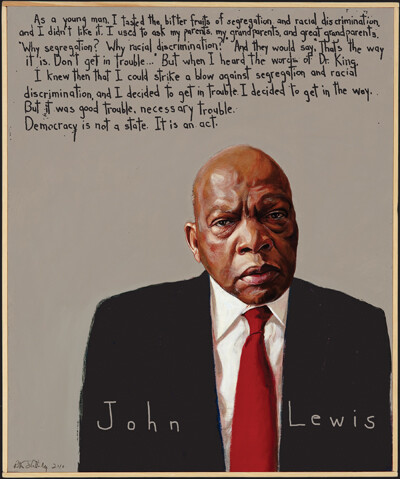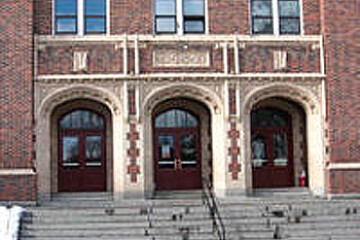Robert Shetterly to Keynote Bozeman Martin Luther King Day Celebration
Robert Shetterly, renowned portrait artist, writer, speaker and advocate for justice and equality, will be the keynote speaker for Bozeman’s Martin Luther King Day Celebration. The event will be held on Tuesday, January 20, at 7:00 PM at the Crawford Theater in the Emerson. Admission is free and open to the public.
In addition to presenting the keynote lecture, Shetterly will also speak to five school assemblies and several Montana State University groups. Bozeman’s Martin Luther King Organizing Committee, which organizes MLK events annually and of which I am a member, has conceived and organized Shetterly’s visit to Bozeman. I have known Rob Shetterly for many years, have owned his book and given copies to friends and family, and have always held him in high regard. I am thrilled that the committee has successfully made these arrangements.
Mr. Shetterly’s book, Americans Who Tell the Truth, showcases fifty of his 200 portraits of Americans throughout our history who have devoted their lives to justice and equality. Images of his portraits will be shown during all of his presentations, and twelve will be on display at Wild Joe’s Coffee Spot during the month of January. 
The profound impact of the Martin Luther King, Jr. project on the community is best summed up in this excerpt from a letter of support from Bozeman’s Rev. John Soderberg:
“...Our youth need positive role models and mentors such as Robert Shetterly and the social justice heroes of American history that his artwork and stories portray. We must not lose those stories, their values, and the rich heritage that his artwork brings to life..”
An important mission of the MLK Day organizing committee is to bring the lessons and passion of the Civil Rights movement, its history, tears and rejoicing, tragedies and defeats and its ultimate victories, to the youth of Bozeman. This history is too important to our current understanding of where we are today to be forgotten.
As a veteran of the civil rights era, I was asked last year to keynote the civil rights portion of the Human Rights Day celebration at one of Bozeman’s schools. I emphasized the role of students and youth in past struggles to defeat segregation and to gain equal rights for African American citizens. It’s important that our youth know about the three thousand students who left their classrooms and marched on downtown Birmingham, Alabama - the “children’s crusade” envisioned and led by Dr. King.
Robert Shetterly is passionate about sharing the lessons of the historic struggle for justice and equality, and we are thrilled that he will do so in our schools.
In an Op-Ed last year signed by members of the committee, we said:
“Whatever one’s dream of justice, one’s version of a moral society, one’s understanding of progress towards true equality, it is worthwhile to be aware of precedents, knowing that no one is too young to speak up and to stand up for their principles. Emphasizing the role of young people in civil rights history reminds them of the importance of becoming part of the process, not simply watching events go by, and that no man, as Dr. King said in Birmingham, can ride your back unless it is bent.”
Robert Shetterly has spoken to students in 26 states. We are proud to have scheduled him to speak to up to 2000 young people in Bozeman schools and at MSU. Shetterly’s portraits are of individuals who exemplify the qualities and the courage displayed in those epic actions for desegregation, and many who were active participants.
John Lewis is my favorite example. He was the youthful leader of the Southern Christian Leadership Conference, an activist as a teenager, participating in sit-ins at stores denying service to blacks. He led the Selma Alabama “Bloody Sunday” march, the first of the unarmed marchers beaten by vicious armed Alabama state police on the Pettus Avenue Bridge. The agony of those terrible attacks - Lewis was hospitalized with a fractured skull - in Selma and in countless other confrontations, is still clearly etched into his features which retain that patina of pain. Shetterly told me once that, in the stunning portrait of John Lewis, he wanted to show his “woundedness.”
Robert Shetterly, born in 1946 in Cincinnati, Ohio, graduated in 1969 from Harvard College with a degree in English Literature. Courses there in drawing changed the direction of his creative life -- from the written word to the image. Also, during this time, he was active in the struggle for Civil Rights.
After moving to Maine in 1970, he taught himself drawing, printmaking, and painting, illustrating widely. He did newspaper editorial page drawings, illustrated National Audubon’s children’s newspaper Audubon Adventures, and approximately 30 books.
Robert´s paintings and prints are in collections all over the U.S. and Europe. A collection of his drawings & etchings, Speaking Fire at Stones, was published in 1993. He is well known for his series of 70 painted etchings based on William Blake’s “Proverbs of Hell”, and for 50 painted etchings reflecting on the metaphor of the Annunciation.
For more than twelve years he has been painting the series of portraits Americans Who Tell the Truth, which has traveled around the country since 2003. Venues have included university museums and grade school libraries, sandwich shops, the Cathedral of Saint John the Divine in New York City, and the Superior Court in San Francisco. In 2005, a book of the portraits by the same name was published, winning the top award of the International Reading Association for Intermediate non-fiction. 
The portraits have given Shetterly an opportunity to speak with children and adults around the country about the lives, actions and impact on our history of the women and men whom he has painted. My daughter, a Bozeman teacher for 20 years, will get her long time wish when he speaks to her classes in January.
Shetterly engages in a variety of political and humanitarian work with people whose portraits he has painted. In 2007, he traveled to Rwanda with Lily Yeh and Terry Tempest Williams to work in a village of survivors of the 1994 genocide. He often works to call attention to continued systemic racism in the US.
Among many awards, he has received a Distinguished Achievement Award from the University of Southern Maine, Honorary Doctorates of Humane Letters from University of New England and from UMaine Farmington. He is a Woodrow Wilson Visiting Fellow, enabling him to do week long residences in colleges around the country.
Shetterly has written about his motivation to begin painting the portraits and traveling the country to share them and the subjects’ stories. His goals cover a wide spectrum of the issues to be confronted in the company of and with the wisdom of those persons of history whom he considers to be “Americans who tell the truth.”
I have taken the liberty of extracting from his texts those words and ideas which, while always addressing the pursuit of justice, equality and truth, are specifically relevant to our annual celebration of the life of Martin Luther King, Jr. and the history of Civil Rights.
He wrote that he began painting this series of portraits - finding great Americans who spoke the truth and combining their images with their words - in 2002 as a way of channeling his anger and grief after 9/11. In the process, he said, his respect and love for these people and their courage helped to transform that anger into hope and pride and allowed him to draw strength from this community of truth tellers, finding in them the courage, honesty, tolerance, generosity, wisdom and compassion that have made our country strong.
His original goal was to paint fifty portraits, but he’s well beyond that and has decided to paint many more. The more he’s learned, he says, about American history -- past and present -- the more people he’s discovered whom he wants to honor in this way. The paintings, he decided, will stay together as a group. He believes that “the courage of these individuals needs to remain a part of a great tradition, a united effort in respect for the truth, that these people form the well from which we must draw our future.”
Twelve years ago, Shetterly wrote that he was choosing to paint icons of the historical struggle for justice and equality who had stood up against powerful people and systems which had denied them their rights and dignity. These truth tellers can help us, Shetterly has written, but we have to know their stories.
He realized that before he started the painting, traveling and talking, he had never experienced the joy that comes from being a member of a community working for a just future. He concluded that one’s deepest happiness is found in the shared spirit of working together for a good cause.
Shetterly is proud that the portraits offer a link between the community of people who struggled for justice in our past and those who are doing it now. He says that to participate in that struggle can be very hard, but it is also a place to find deep friendship, shared courage, respect and dignity.
Robert Shetterly’s visit is a rare and valuable moment for Bozeman. The organizing committee is excited about the agenda we have created for his time here, and look forward to a great many Bozeman citizens having the opportunity to see his portraits and to hear him speak.
Dan Lourie is a citizen of Bozeman with a history of advocacy for justice and equality dating back to the Civil Rights movement. He has written often about Dr. King, and is a member of the Martin Luther King Day Organizing Committee.

